At 250°F, figure on cooking a pork shoulder for 10 hours. Once it’s done cooking, I like to let the meat rest in an insulated cooler for 1 to 2 hours. It’s a long cook, but to make world-class pulled pork, the time investment is worth it.
Although I am a big believer in tracking internal temperature, I understand that it’s important to have a rough timeline. This is why I timed several of my cooks and did some “meat math.”
I think pulled pork belongs on the Mt. Rushmore of BBQ meat. It’s forgiving, delicious, and affordable. I’ll go over everything you need to know to churn out perfectly smoked pork shoulder cooked at 250°F. I’ll also drop my best tips for maintaining a consistent temperature in your cooker throughout. Let’s get started!
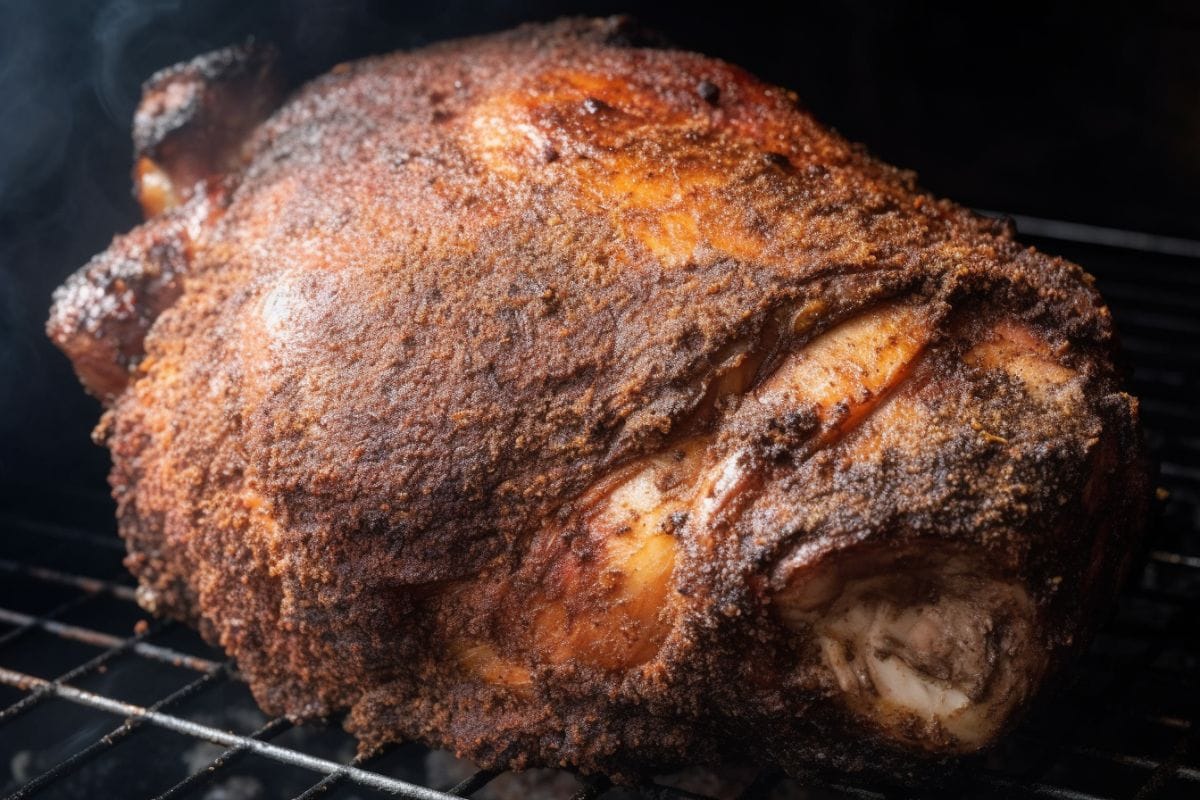
At 250°F, pork shoulder will take around 10 hours to cook. The weight of the cut isn’t a huge factor. A whole 10-pound shoulder that contains both the butt and the picnic will take about the same time as smoking a 5-pound butt.
This is because the whole shoulder isn’t any thicker – it’s just longer. So it cooks at roughly the same speed. So whether you’re smoking a 5-pound partial shoulder or a 10-pound whole shoulder, figure you’re in for 10 hours worth of cooking.
Bear in mind that this is just an estimate. There are a ton of factors surrounding the smoking process like humidity, your smoker, the temperature outdoors, and more. It may take you more or less time to cook your pork shoulder.
To be sure that your pork shoulder is cooked to perfection, it’s important to check the internal temperature. A smoked pork shoulder is considered done at between 195°F and 204°F. My personal sweet spot is at 203°F. A probe or toothpick should slide into the shoulder with no resistance, and when you pull the pork, it should shred easily.
Yes, it is important to have rough time estimates for how long to smoke a pork shoulder at 250°F. But you can’t put all your faith in time. In BBQ, we cook to temperature and doneness, not time.
Use time as a rough guideline for when to check the smoked pork shoulder for doneness.
Pork butt and pork shoulder are often used interchangeably, so it’s natural that you may be wondering how long it takes to smoke a pork butt.
I’ll make it easy for you – pork butt cooks at the same rate as pork shoulder at 250°F. Plan on cooking that bad boy for around 10 hours before it’s done.
Related Reading
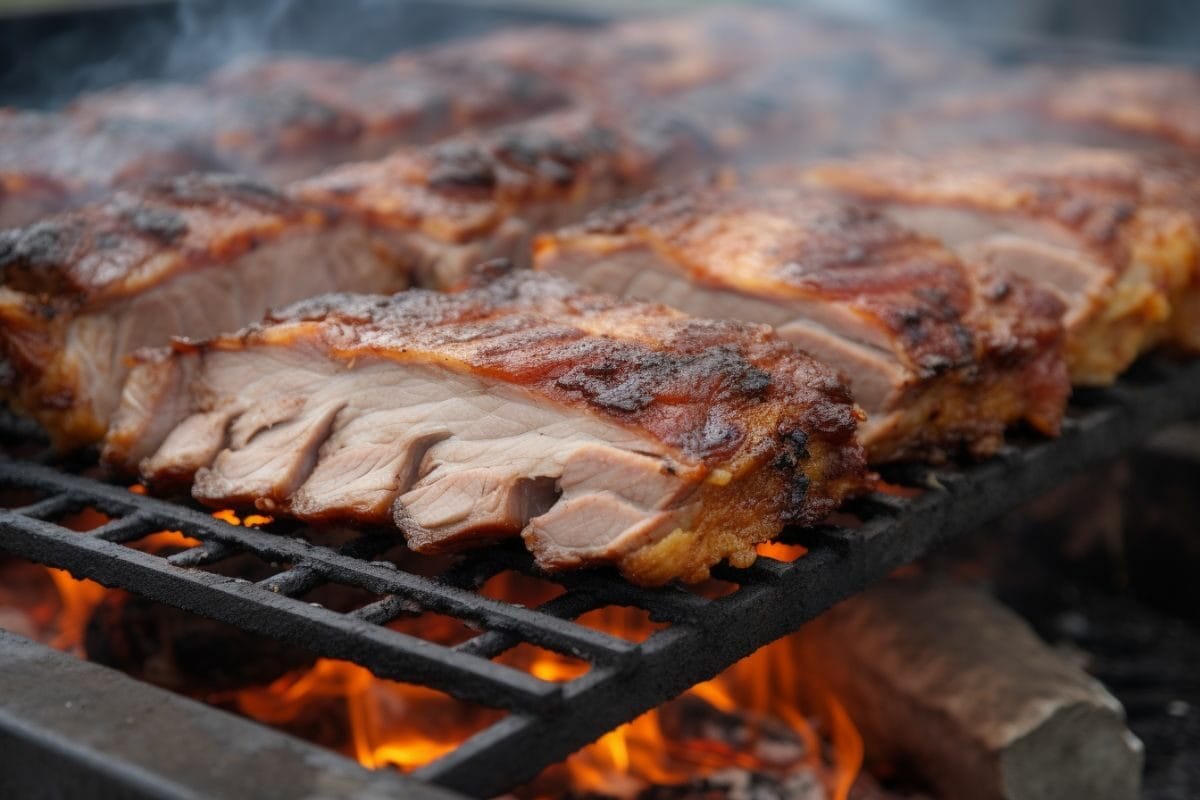
It actually doesn’t matter too much whether you smoke pork shoulder at 225°F or 250°F. Pork shoulder is a forgiving cut of meat, so if your temp flares to 250°F or you want to speed up the cook a little bit, go for it. Plenty of pitmasters smoke their pork shoulder at 250°F (including me) and crank out world-class pulled pork. Don’t sweat the small stuff, gang.
Just know that at 250°F, the pork shoulder will cook a little faster. Keep an eye on the internal temp.
Here are some guidelines to follow when making slow-cooked pork shoulder:
Yes, the weather can have an impact on the temperature inside your cooking chamber if you’re using a stick burner or charcoal smoker. Which can impact the speed at which your pork shoulder cooks.
On hotter days, the cooking chamber is going to heat up more quickly. In fact, it is possible that it will shoot past 250°F if you’re using charcoal or wood. Keep an eye on that dome thermometer!
If you’re using a pellet grill or electric smoker, the temp is set it, and forget it – exterior weather temperatures won’t bother you.
With cold temps, you have the opposite problem. The trick here is to ensure that the smoker temp remains high enough so that the meat will cook at the proper rate.
Wind can give pitmasters fits. It can increase airflow and spike your cooker temperatures. Try to find a place to stick the smoker so that it is partially blocked from the wind. Never keep a smoker in an enclosed indoor area, though – it has to be in an open-air space.
If you are using a charcoal or gas grill, you’ll need to set up a two-zone fire. If you’re using a Kamado smoker, you’ll need a heat deflector.
For a two-zone fire with charcoal, push the coals to one side. On a gas grill, simply turn on the burners on one side. The side with the fire is your direct heat.
The indirect heat area is where there are no coals or the burners are turned off. Place your pork shoulder in the indirect zone.
Some smokers are already equipped with a dome thermometer. If I were you, though, I wouldn’t trust these. They are often the cheapest part of the grill or smoker. I once owned a grill whose dome thermometer was off by 75°F. That’s significant! It didn’t take me long to figure out that my food was cooking way too fast.
Get yourself a good quality thermometer that you can place inside the cooking chamber. A probe that gets a reading right at the grill grates will tell you exactly what temperature your meat is cooking at. A good thermometer is a chef’s best friend.
I’m a fan of the Thermoworks Smoke, although a number of wireless Bluetooth thermometers have hit the market recently that are super cool. I’ve been eyeballing this Meater wireless smart thermometer.
These thermometers make it easy to get an accurate smoker temperature. You will also be able to take note of any temperature fluctuations during the cook.
Keeping your cooking chamber at a stable temperature means that your smoked pork shoulder will cook at a consistent rate, too.
Most charcoal smokers have vents – make sure you understand how these work so you can maintain the smoker temp.
The more the vents are open, the more air coming in. The oxygen fuels the flames, causing the temperature to rise. Close the vents, and the temperature inside the cooking chamber will go down.
Small adjustments to the vents can have a big impact on the cooking temperature. Kamado grills have a ridiculous amount of insulation and take forever to cool down. If you’re using one, don’t let it go past your target temperature!
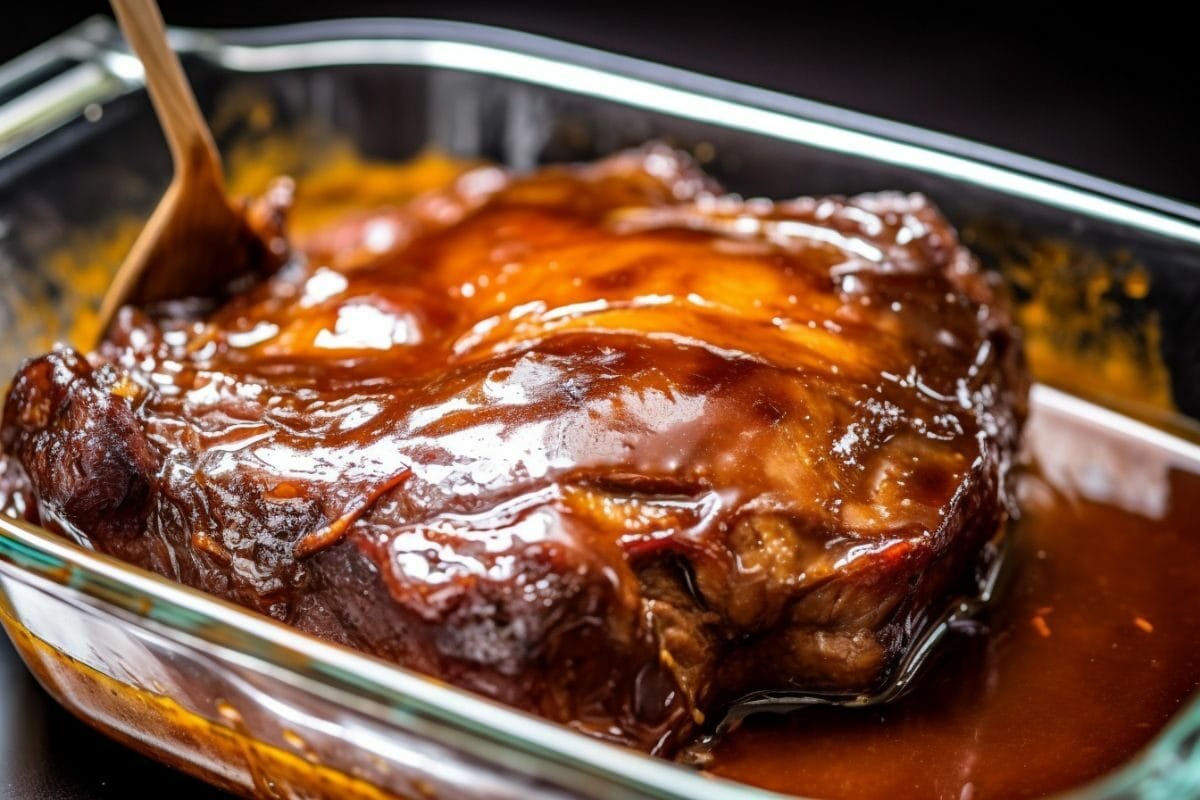
If you are cooking a whole pork shoulder or a larger cut at 250°F, you’re going to hit the stall. This is when the internal temperature of the pork shoulder remains at the same temperature for several hours.
This typically happens between 150°F and 170°F.
To overcome the stall, you need to wrap the smoked pork shoulder in either aluminum foil or butcher paper (my preference). Then, return it to the smoker. The wrap traps moisture and will push you past the stall. It also tenderizes the meat.
Keep close track of the cooking process to know exactly when you should wrap the meat. Once your pork shoulder is between 150°F and 170°F, and the internal temp stops rising, it’s time to wrap.
Related Reading
The main reason for smoking pork shoulder is to make pulled pork – pulled pork sandwiches – in particular. If you want to prepare the most lip-smacking dish, here are the tips to follow:
I know that boneless pork shoulder is slightly easier to deal with.
But bone-in shoulder packs more flavor. It also produces juicier meat. For maximum flavor, go with bone-in.
Fat plays an important role when smoking meat. It insulates the meat, and the intramuscular fat is one of the reasons pork shoulder tastes so darn good.
But despite what you may have read elsewhere, the fat cap doesn’t render. You don’t want to serve that white, flabby meat to your guests, believe me. Trim it to around ⅛” to ¼.” Point the cap in the direction that your heat is coming from to insulate the meat (up on a pellet smoker, down on charcoal smokers, to the side for a stick burner).
When smoking the pork shoulder for an extended period of time, there is always a risk of the meat drying out. Say no to dry pork! Dry brine your meat or inject it with a marinade.
For dry brining, all you need is some Kosher salt. Sprinkle it on the shoulder and refrigerate overnight. Use ½ teaspoon of Kosher salt per pound or ¼ teaspoon of table salt per pound. Dry brining is my go-to hack for great pulled pork.
If you can’t dry brine ahead of time, then injecting is the way to go. Some pitmasters us apple cider vinegar or apple juice. Melted butter is another option, but you are free to choose whatever tasty liquid you like.
Some pitmasters love the injection method – while I prefer to plan ahead and dry brine, try both and see what works for you.
I prefer a simple pork shoulder rub, especially if I’ll be adding barbeque sauce to the pulled pork.
My go-to recipe involves brown sugar, smoked paprika, garlic powder, onion powder, cayenne pepper, cumin, and black pepper. Use ⅓ cup of your favorite rub per 5 pounds of pork.
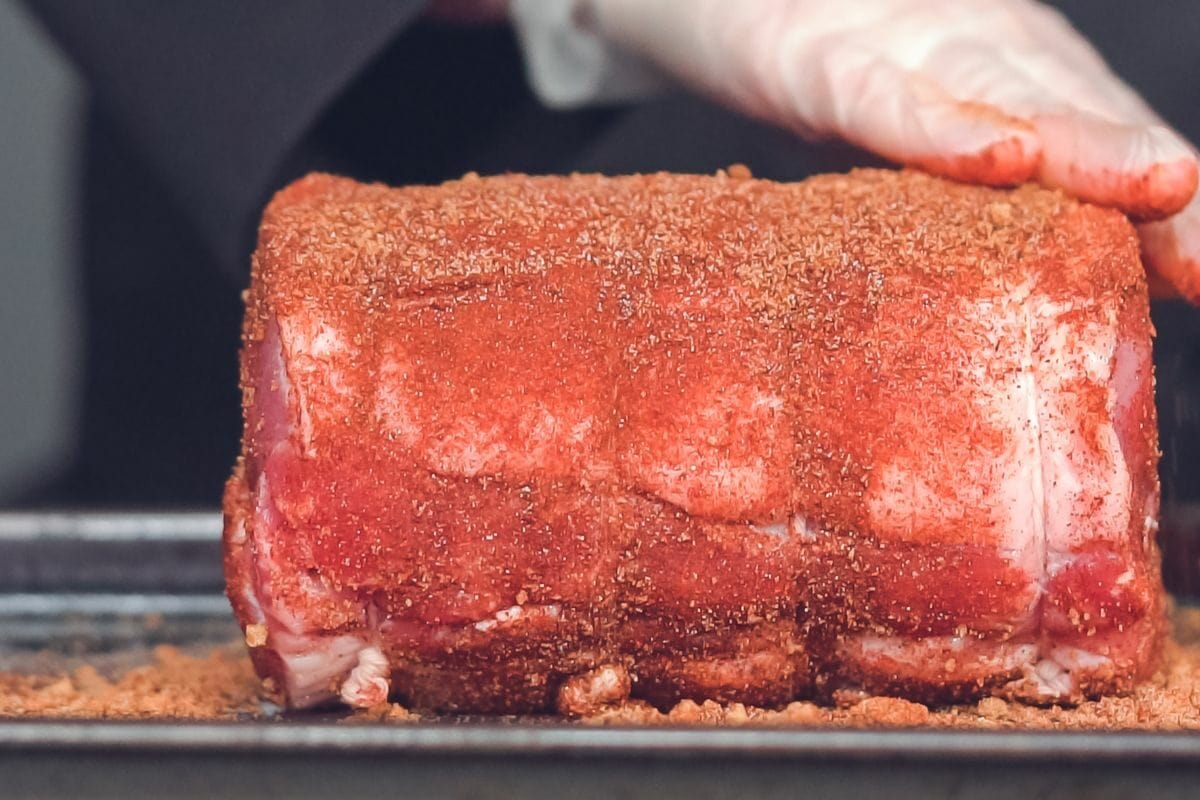
If you want something very mild, apple and cherry are your best choices. If you like a smokier taste, then you can’t go wrong with oak – a true Texas classic. Pork shoulder is rich and fatty, and pairs well with almost any wood.
Hickory is a classic smoking wood for a reason. Try a handful of chunks with your next pork shoulder, and I promise you won’t be disappointed.
Chunks or chips both work, but my preference is for chunks. If you’ve got a pellet grill, your pellets are both your fuel and the wood you’ll be smoking with.
With smoked pulled pork, it’s all about going low and slow. If you’re new to the smoking world, welcome! I’d advise you to stick around 250°F the first few times you cook pulled pork. While you can go hotter, that’s an advanced technique that requires a bit more explanation – I’ll save it for another post!
If you cook hotter than 250°F, you risk drying the meat out. You may also not be giving the meat enough time to break down and become more tender. 250°F is basically a foolproof temperature to make pulled pork. The key is to cook the shoulder long enough – to around 203°F, or when a probe slides into that shoulder like a knife through hot butter.
People argue whether the pork shoulder should be placed fat side up or down. I’m here to tell you that the key is to place the pork shoulder so that the fat cap is facing the direction of the heat source.
This way, the fat is able to take the brunt of the heat. The rest of the meat is cooked at a slower rate and is less prone to drying out. Leaving you with moist, delicious pork.
Pork shoulder is considered done at 145°F. While the meat is safe to consume at this temperature, it’s nowhere near cooked enough for incredibly tender pulled pork. Pull your shoulder at 145°F, and you’ll have tough and chewy meat that won’t shred.
Smoking for longer not only offers a far better texture – it also makes it easier to pull the meat apart. Cook the pork shoulder until the internal temperature reaches between 195°F to 204°F.
Again, your pork is done when a toothpick slides into the shoulder with no resistance. Once you reach that point, pull it from the smoker – don’t overcook it. Taking the shoulder out at the right point will prevent the meat from overcooking and burning. You also risk drying out the meat if you overcook it.
I rest my shoulder for 1 to 2 hours wrapped up in a cooler. Wrap it in foil (if you didn’t crutch it) and then wrap it in a clean towel, which helps insulate it. Resting pork shoulder produces a more tender end result.
If you absolutely don’t have time to let the shoulder rest, put it into a large pan that will collect all the drippings.
Bear claws or a shredding tool will get this job done best. Forks work, but they require quite a bit more elbow grease.
A pair of heat-resistant gloves are your best friend when shredding pulled pork. Even after resting for an hour, the pork will be screaming hot. Protect your hands with gloves.
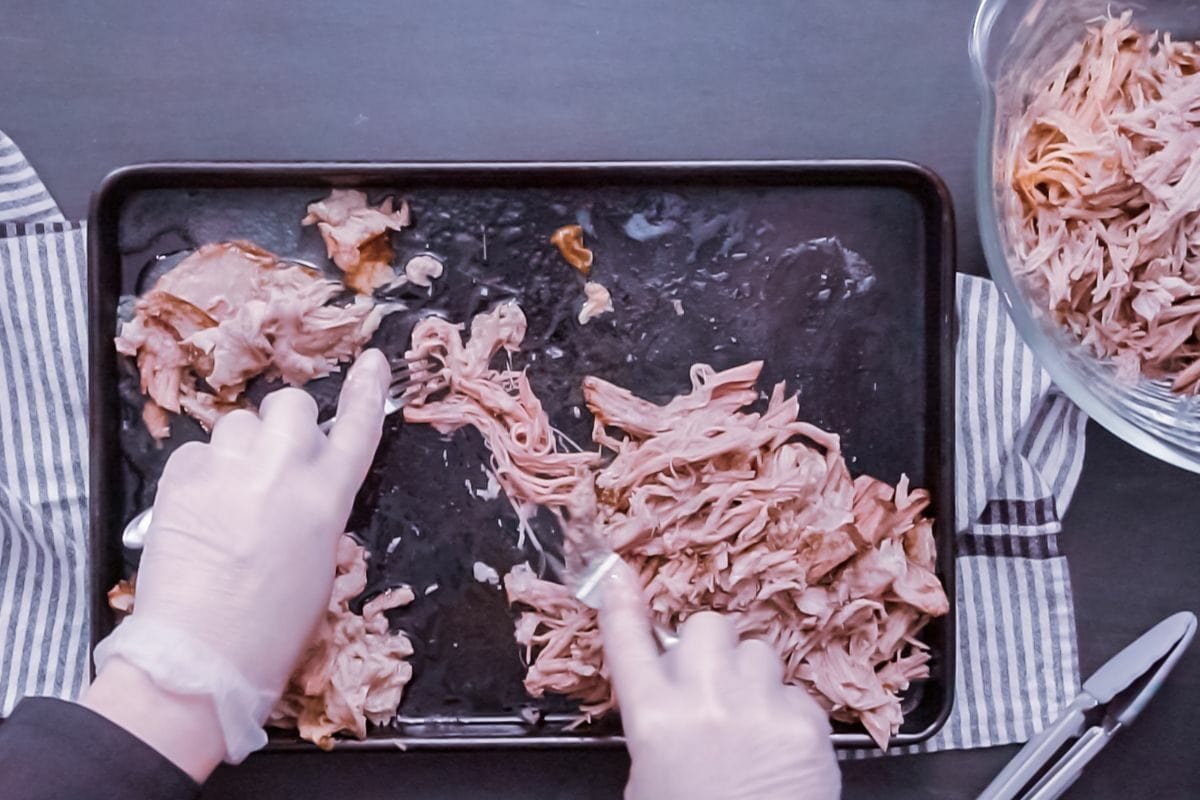
You are free to use your favorite BBQ sauce for the shredded pork. But most commercially available sauces aren’t that great.
They tend to be too sweet. Considering how much hard work you have put into making your pulled pork, I say take it to the next level with the very best sauce. A sauce that you made yourself.
Now, I know that making your own sauce can seem intimidating, but this isn’t the case at all! All you need are a few ingredients, such as brown sugar, apple cider vinegar, Worcestershire sauce, ketchup, and seasonings – ingredients that are probably already in your cupboard.
Trust me – it really will make all the difference.
Related Reading
I figure around 1 pound of pork per person, which will leave me with some leftovers. This also accounts for losses to shrinkage, bone, and fat. Pulled pork stores very well in the freezer.
It takes a little longer to cook pork shoulder at 225°F than it does at 250°F. Plan on 11 hours to smoke at 225°F.
If you were curious about how long to smoke a pork shoulder at 250°F, you now have your answer! I hope this post armed you with all the knowledge you needed to get cooking. Smoking a pork shoulder is an all-day process, but it’s hands-off – your grill or smoker does all the hard work.
Just set your grill up for indirect cooking, keep the temperature hovering around 250°F, and cook the shoulder until it’s ultra tender (around 203°F), and you’ll be good to go. Rest the shoulder for an hour in a cooler if you’ve got the time for the most delicious results. Good luck and happy cooking!